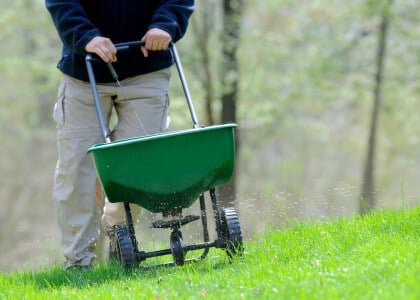
A healthy lawn reduces pollution potential, cools the environment, filters dust and pollen, and contributes to the aesthetics of your home and your neighborhood. It also allows rainwater runoff to be filtered and returned to the groundwater.
1. Good Equipment is Important
A great, sharp mower will make your job much easier. Change the oil and put fresh gasoline in the tank. Replace or sharpen the blade, and keep it sharp during the growing season. If you have someone service your mower, get it in early to avoid the rush.
2. Dethatching
If you have excess thatch and debris on your lawn, it can be removed in fall or early spring. A thatchy lawn can harbor more disease. Have that thatch combed out and cut the grass a bit shorter immediately following the thatch removal. Now you will have nice green foliage emerging. Then maintain the cutting height at 2” or above.
3. Prevent Crabgrass in Spring
Crabgrass is an annual plant that produces many seeds (and should not be confused with quack grass which is a perennial). The seed does not germinate until the soil warms up. Once the plants begin to grow, they are hard to eliminate from the grass plants. A well timed application of pre-emergence is the best way to eliminate those seedlings from growing. A good rule of thumb is to treat before the Lilacs bloom. If you are planning on planting grass seed, do not use pre-emergence or the grass seed will not germinate.
4. Fertilizing
Fertilizer will keep your turf areas thick and looking good. A quality slow release fertilizer is a great way to keep your lawn nice. Many have a tendency to over fertilize and to spray the granules on the roads or driveways, which ends up in the surface water and ground water. Keep the fertilizer on your lawn and sweep it off any hard surfaces.
Our selection of insect & pest control and lawn care & garden maintenance products are widely used by expert gardeners, including us! Our Nutri-Pak fertilizer is especially close to our hearts because it was created right in the heart of Madison at the University of Wisconsin. We're proud to offer these top-of-the-line maintenance products and fertilizers for sale to make your lives easier and plants healthier. Click Here: to shop our wide variety of fertilizers!
5. New Seeding
Planting new grass from seed should be done as the soil warms up. Planting seed into cold wet soil will take much longer to germinate. Preparing the soil so it is loose and raked smooth. Spread the seed and then rake the seed into the top ½” of soil right away. The important thing is to remember that seed needs to remain moist once it has been raked in. Water just until the point at which the water would puddle or run. Light misting during the day is a great way to maintain good moisture until it germinates. The quick germinating grasses come up within a few days, but the real bluegrass seed will take up to 2 weeks to germinate so during that first 2 weeks do not allow that soil to dry out at all or the seedlings that have germinated may die.
6. Watering
Watering turf is really quite simple. Always be sure to water it when it gets dry, but not until it is dry. Water turf enough at one setting to apply about an inch of water. Then do not water it until it starts to dry out. Deep and less frequent watering keeps the roots going down for the water, whereas the light and frequent watering keeps the roots near the surface where they can dry out very quickly. Remember to maintain your lawn areas at a height of 2” or more during the growing season for best results.

